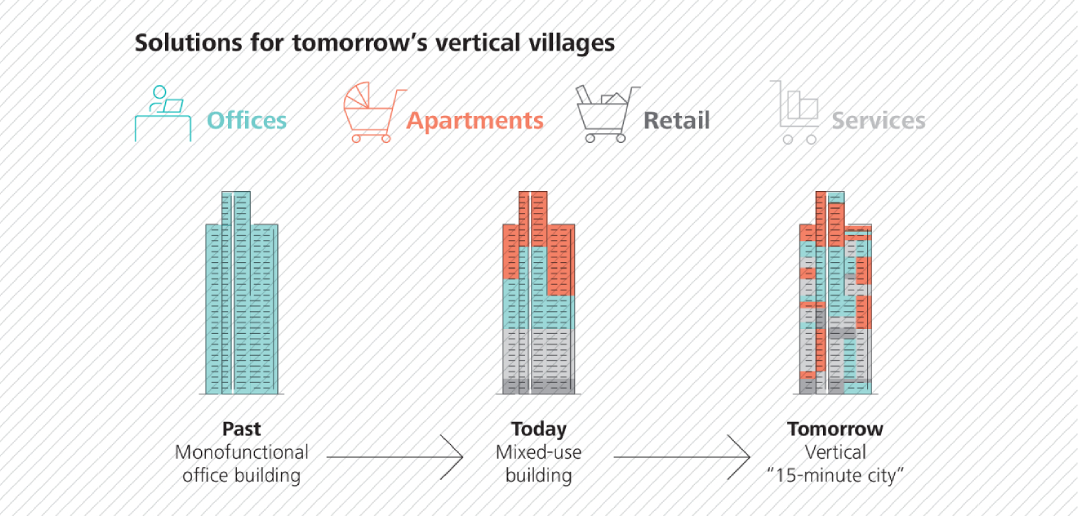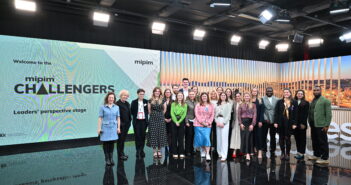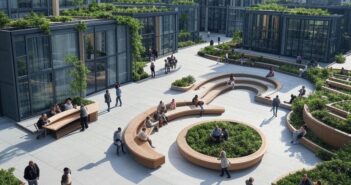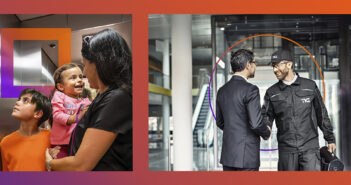Our cities have been the beating hearts of progress and innovation for decades. Yet, with cities responsible for 70% of global greenhouse gas emissions, they have become the frontline in the fight against climate change.
New buildings may be more energy efficient, but 80% of buildings that will be standing in 2050 have already been built. Demolition and reconstruction are not a viable option, given the environmental cost. So, what’s the game plan? Repurposing. Many cities consist of towers designed for a single function – which is no longer a sustainable approach. As office vacancy rates continue to rise globally, quite a few of these buildings find themselves only partially occupied. We need to build structures that can be re-purposed throughout their lifetime to adapt to different purposes over time, and we need to ensure existing buildings exhibit the same adaptability. One of the main obstacles to creating adaptable buildings lies in the elevator system, which is typically configured around the initial use of the building and is challenging to modify.
Schindler MetaCore, an elevator system for the future, aims to change all that –reshaping the way we perceive and design our urban landscapes.
Adaptability front and centre
Schindler MetaCore offers an alternative to demolition when buildings become underutilized or outgrow their original purposes. Traditionally, the practice of repurposing buildings has entailed significant costs, time, and energy expenditure, often resulting in wasteful practices. However, Schindler MetaCore empowers building owners to explore reconfiguration options that not only conserve resources, but also unlock new uses and increase the building’s lifespan.
A range of applications
The versatility of Schindler MetaCore works both for new constructions and existing buildings. For building owners seeking to repurpose their existing properties into flexible multi-use buildings, we start the process by assessing the suitability of their buildings for repurposing, providing building owners with different reconfiguration options, using simulation-based technology. A primary pain point addressed by Schindler MetaCore is the inefficiency in traditional elevator systems within mixed-use buildings. Typically, such buildings have separate elevator cores, resulting in wasted space and operational complexities. Schindler MetaCore disrupts this convention by enabling a single set of meticulously coordinated elevator units to serve diverse passenger groups, thereby reducing construction costs and enhancing operational efficiency through intelligent traffic management systems.
Innovative functionality of Schindler MetaCore
Schindler MetaCore leverages innovative design and technological integration to deliver on its promise. Through the utilization of through-car elevators capable of servicing two distinct lobbies on the same floor and the strategic grouping of lobbies by function on separate floors, Schindler MetaCore ensures tailored elevator journeys aligned with the needs of different passenger groups. Schindler MetaCore runs on our pioneering building transit management technology Schindler PORT 4D. The integration of the myPORT app facilitates seamless user experiences by intuitively directing passengers to the most efficient elevator cabin based on their destination.
Elevating urban environments with Schindler MetaCore
By facilitating the repurposing of existing buildings, Schindler MetaCore minimizes the need for new construction and its associated carbon footprint. Additionally, the flexibility afforded by Schindler MetaCore fosters innovation and resilience in urban planning, enabling cities to adapt to evolving demographic and economic trends with agility. Schindler MetaCore also has the potential to improve the liveability of urban environments by creating dynamic and inclusive spaces where people can live, work, and socialize in close proximity. By promoting mixed-use developments, Schindler MetaCore supports vibrant communities and fosters social cohesion, ultimately enriching the urban experience for residents and visitors alike.
A vision for the future
As urbanization continues to accelerate globally, we can expect the demand for flexible and adaptable building solutions will only intensify. Schindler MetaCore offers a forward-thinking approach to building design and operation that puts adaptability at the forefront. Solutions like Schindler MetaCore will foster resilient, sustainable, and inclusive urban environments that enhance quality of life for all inhabitants.
Looking ahead: Embracing a future of flexibility
In the coming years, we can expect to see the widespread adoption of flexible building solutions like Schindler MetaCore as cities strive to optimize resource utilization, reduce environmental impact, and enhance the quality of life for their residents. By embracing innovation and collaboration, urban stakeholders can work together to create a future where buildings are not static structures but dynamic spaces that evolve and adapt to meet the changing needs of society. In conclusion, Schindler MetaCore represents a leap forward in building design and operation, offering a glimpse into a future where flexibility and adaptability are incorporated into urban design.




